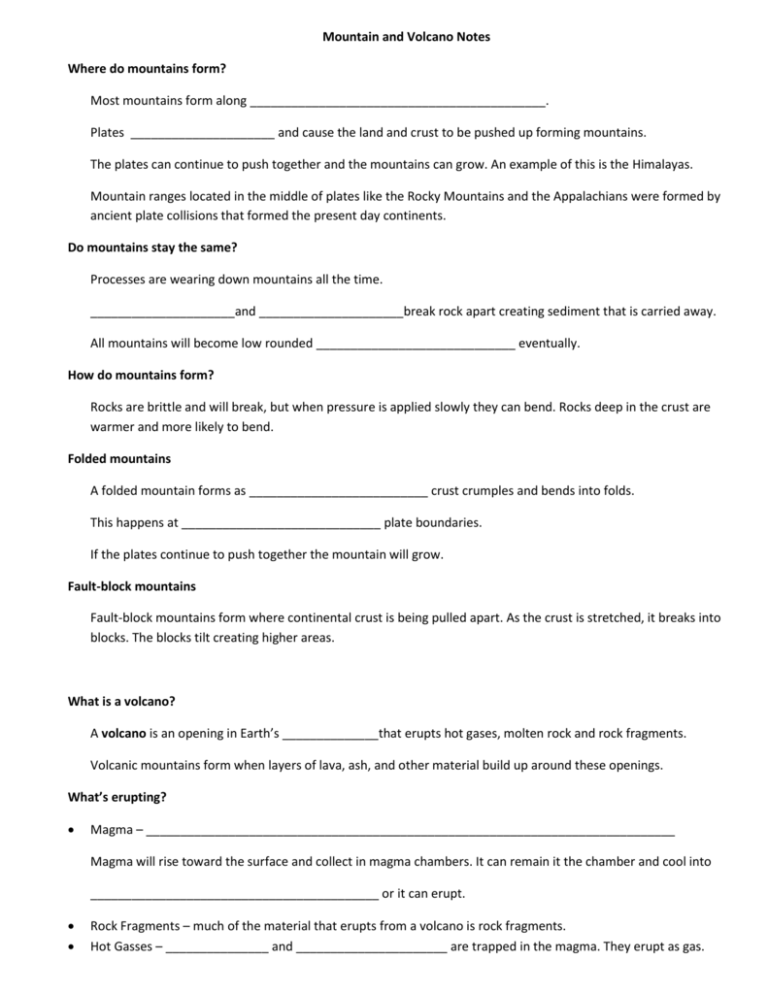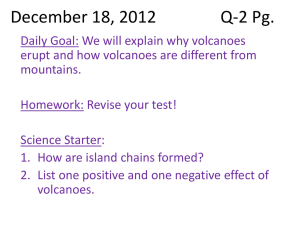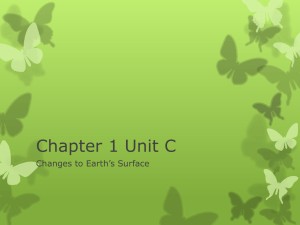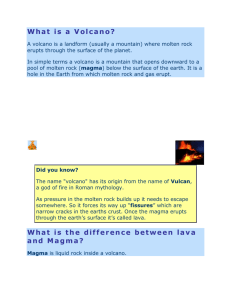Mountain and Volcano Notes Where do mountains form? Most
advertisement

Mountain and Volcano Notes Where do mountains form? Most mountains form along ___________________________________________. Plates _____________________ and cause the land and crust to be pushed up forming mountains. The plates can continue to push together and the mountains can grow. An example of this is the Himalayas. Mountain ranges located in the middle of plates like the Rocky Mountains and the Appalachians were formed by ancient plate collisions that formed the present day continents. Do mountains stay the same? Processes are wearing down mountains all the time. _____________________and _____________________break rock apart creating sediment that is carried away. All mountains will become low rounded _____________________________ eventually. How do mountains form? Rocks are brittle and will break, but when pressure is applied slowly they can bend. Rocks deep in the crust are warmer and more likely to bend. Folded mountains A folded mountain forms as __________________________ crust crumples and bends into folds. This happens at _____________________________ plate boundaries. If the plates continue to push together the mountain will grow. Fault-block mountains Fault-block mountains form where continental crust is being pulled apart. As the crust is stretched, it breaks into blocks. The blocks tilt creating higher areas. What is a volcano? A volcano is an opening in Earth’s ______________that erupts hot gases, molten rock and rock fragments. Volcanic mountains form when layers of lava, ash, and other material build up around these openings. What’s erupting? Magma – _____________________________________________________________________________ Magma will rise toward the surface and collect in magma chambers. It can remain it the chamber and cool into __________________________________________ or it can erupt. Rock Fragments – much of the material that erupts from a volcano is rock fragments. Hot Gasses – _______________ and ______________________ are trapped in the magma. They erupt as gas. Where Volcanoes form Volcanoes form along ________________________________________________. When a plate sinks under another it melts forming _______________________________________. When plates move apart magma rises from the ______________________________________. Hot Spots can also form volcanoes. 3 Basic Volcano shapes 1. Shield Volcano Quiet eruptions of basaltic lava spread out in ___________________________. The buildup of these layers forms a _____________________ dome volcano with gently sloping sides. The shapes of these volcanoes reflect the fact that they are constructed of lava flows that erupted nonexplosively. 2. Cinder Cone Volcano A steep cone shaped hill volcano built of a _______________________ of _____________________________. Formed by volcanic cinders, bits of solidified lava, and bits of rocks thrown into the air during an eruption & then fall back down around the vent (volcanic opening) forming a steep-sided loosely packed volcano. 3. Composite Volcano A tall cone that is built of layers of ____________________and rock fragments it‘s built of magma that is high in silica and flows like ____________________. These volcanoes erupt violently because of the trapped gasses and hardened lava plugs the opening. The rock must be blown out before more magma can escape. Label the drawings: Scientists monitor volcanoes Scientists are able to _____________________________that a volcano is becoming active and will erupt. Even close monitoring cannot prevent property damage, but lives can be saved by warning people to move away from the area.







